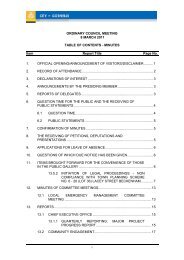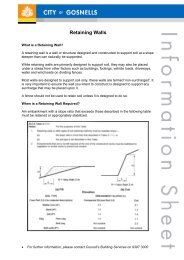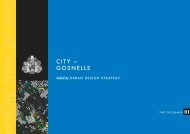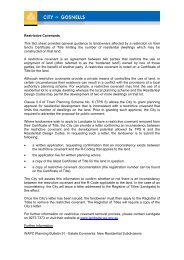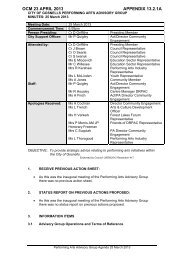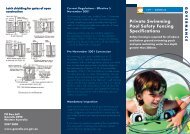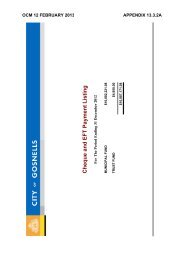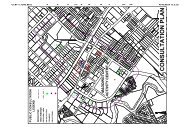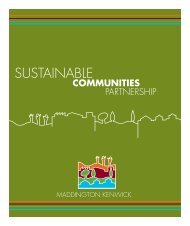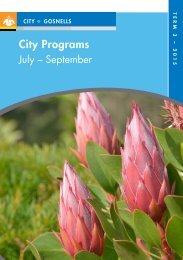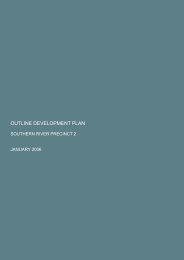Summary - City of Gosnells
Summary - City of Gosnells
Summary - City of Gosnells
You also want an ePaper? Increase the reach of your titles
YUMPU automatically turns print PDFs into web optimized ePapers that Google loves.
Vegetation 69The multivariate analysis (Appendix C) conducted on the floristic data collected in the quadrats <strong>of</strong> theMKSEA in combination with the SCP dataset <strong>of</strong> Gibson et al. (1994) (‘the SCP dataset’), provided someobjective evidence <strong>of</strong> the occurrence <strong>of</strong> the three threatened FCTs 3a, 8 and 20a in the MKSEA (Table 5.5,Column 3). The classification dendrogram <strong>of</strong> the quadrat only data (‘DEN quads’) from the MKSEAprovided more unequivocal results than the Nearest Neighbour analysis (‘NNB’) (Table 5.5, Column 4). Therelationships between the relevés (that were surveyed in the more degraded areas <strong>of</strong> the MKSEA) and theSCP dataset in the ‘DEN all’ classification (Appendix C, Table 2) were less clear. The habitat data collectedin the current survey provided additional resources for dealing with some <strong>of</strong> the shortfalls in the purelyfloristic approach to vegetation classification that is <strong>of</strong>ten used to determine the conservation value <strong>of</strong>vegetation on the SCP.The relevés (that were surveyed in the more weedy areas <strong>of</strong> the MKSEA) tended to group preferentially withquadrats <strong>of</strong> the MKSEA in the ‘DEN all’ classification rather than with SCP dataset sites (Appendix C,Table 2). This is a common occurrence that has been observed in such analyses that is consistent with thegeneral ecological relationship <strong>of</strong> distance decay. The similarity indices that were used in the analysis wereinfluenced by both presence and absence <strong>of</strong> species. Therefore, both a deficit in native species numbers and asurplus <strong>of</strong> weeds in the MKSEA relevés contributed to decreasing the similarity between MKSEA relevésand SCP dataset sites. The addition <strong>of</strong> relevé data to quadrat data in the MKSEA (the ‘DEN all’) analysisresulted in a disruption <strong>of</strong> the pattern observed between the quadrat data and the SCP data in the ‘DENquads’ analysis and did not provide additional insights. Thus, the discussion below is confined mainly to the‘DEN quads’ (Table 5.5, Column 3) and ‘NNB’ (Table 5.5, Column 4) results rather than the ‘DEN all’results.Quadrats 4, 6, 8, 10, 11, 12, 15, 16, 17, 19, 20, 22 and 28 <strong>of</strong> the MKSEA were sampled in the most speciesrichand undisturbed vegetation <strong>of</strong> the survey area, and Relevés 14, 24 and 26 were analysed with them, asquadrats. All <strong>of</strong> these quadrats (except 15, 16 and 27, the only three sites with affinities to FCT 11) clusteredin the classification <strong>of</strong> the quadrat data ‘DEN quads’ with three FCTs <strong>of</strong> the SCP that are ThreatenedEcological Communities (3a, 8 and 20a) (Table 5.5, Column 3). The nearest neighbours for the quadrats <strong>of</strong>the MKSEA in the NNB analysis were (as expected) other quadrats and relevés from the MKSEA, followedby sites <strong>of</strong> the SCP dataset from FCTs 3a, 8, 20a and other FCTs. Any ambiguities that were added to therelatively simple ‘DEN quads’ pattern by the NNB results provided further insights about the MKSEAquadrat sites.The multivariate analysis <strong>of</strong> the MKSEA sites against the SCP dataset produced ambiguous results withregard to all MKSEA sites where Muchea Limestone was identified in the stratigraphic or hydrologicalsurvey. This is significant as Gibson et al. (1994) (‘the SCP survey’) did not identify any vegetationinhabiting Muchea Limestone as a FCT. Firstly, the SCP survey was limited to publicly owned land andthere was no extant native vegetation on limestone outcrops within these lands on the eastern side <strong>of</strong> theSCP. Secondly, the SCP survey did not investigate habitat in sufficient detail to detect the potential presence<strong>of</strong> calcareous sediments unless it was a surface outcrop. Thirdly, the SCP survey did not generally include avery representative sample <strong>of</strong> seasonal wetland sites. Fourthly, the SCP survey used only floristic data todetermine clusters <strong>of</strong> sites. The Muchea Limestone TEC as currently defined (Keighery and Keighery, 1995;English and Blyth, 2001) is not a Floristic Community Type. It is a heterogeneous suite <strong>of</strong> native vegetationtypes that inhabit a specific but rare habitat on the eastern SCP.Consideration <strong>of</strong> the multivariate analysis summary (Table 5.5, Column 5) with the ecological evidence fromthe MKSEA survey leads to the inference that six groups (A, B, C, D, E and F) <strong>of</strong> sites that correspond toFCT 3a, FCT 20a, FCTs 7/8/10a, ML, Degraded Sites and Unassigned Sites occur in the MKSEA. The 32MKSEA floristic sites and their groups and conservation values are listed in Columns 6a and 6b <strong>of</strong> Table 5.5,and the groups <strong>of</strong> FCTs and the sites assigned to them are discussed below.Tauss, C. and Weston, A.S. (2010). The flora, vegetation and wetlands <strong>of</strong> the Maddington-Kenwick Strategic Employment Area.A survey <strong>of</strong> the rural lands in the vicinity <strong>of</strong> the Greater Brixton Street Wetlands. Report to the <strong>City</strong> <strong>of</strong> <strong>Gosnells</strong>, W.A. Version 18.04.10



